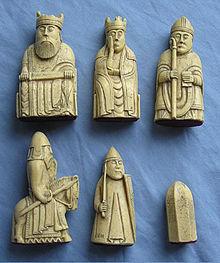
MODERN GAME
Origins of the modern game[edit]
The queen and bishop remained relatively weak until[13] between 1475 AD and 1500 AD, in either Spain, Portugal, France or Italy, the queen's and bishop's modern moves started and spread, making chess close to its modern form. This form of chess got such names as "Queen's Chess" or "Mad Queen Chess" (Italian alla rabiosa = "with the madwoman").[49] This led to much more value being attached to the previously minor tactic of pawn promotion.[18] Checkmate became easier and games could now be won in fewer moves.[47][50] These new rules quickly spread throughout Western Europe and inSpain,[51][52] with the exception of the rules about stalemate, which were finalized in the early 19th century.[53] The modern move of the queen may have started as an extension of its older ability to once move two squares with jump, diagonally or straight. Marilyn Yalom says that the new move of the queen started in Spain: see history of the queen.
In some areas (e.g. Russia), the queen could also move like a knight.
A poem Caïssa published in 1527 led to the chess rook being often renamed as "castle", and the modern shape of the rook chess piece; see Vida's poem for more information.
An Italian player, Gioacchino Greco, regarded as one of the first true professionals of the game, authored an analysis of a number of composed games that illustrated two differing approaches to chess.[14] This influential work went to some extent in popularizing chess and demonstrated the many theories regarding game play and tactics.[14]
The first full work dealing with the various winning combinations was written by François-André Danican Philidor of France, regarded as the best chess player in the world for nearly 50 years, and published in the 18th century.[14] He wrote and published L'Analyse des échecs (The Analysis of Chess), an influential work which appeared in more than 100 editions.[14]
-
A tactical puzzle fromLucena's 1497 book
-
A Russian set made ofwalrus ivory, 1750s
-
Original Staunton chess pieces by Nathaniel Cook from 1849
Writings about the theory of how to play chess began to appear in the 15th century. The oldest surviving printed chess book, Repetición de Amores y Arte de Ajedrez (Repetition of Love and the Art of Playing Chess) by Spanish churchmanLuis Ramirez de Lucena was published in Salamanca in 1497.[51] Lucena and later masters like Portuguese Pedro Damiano, Italians Giovanni Leonardo Di Bona, Giulio Cesare Polerio and Gioachino Greco or Spanish bishop Ruy López de Segura developed elements of openings and started to analyze simple endgames. In the 18th century the center of European chess life moved from the Southern European countries to France. The two most important French masters wereFrançois-André Danican Philidor, a musician by profession, who discovered the importance of pawns for chess strategy, and later Louis-Charles Mahé de La Bourdonnais who won a famous series of matches with the Irish master Alexander McDonnell in 1834.[54] Centers of chess life in this period were coffee houses in big European cities like Café de la Régencein Paris[55] and Simpson's Divan in London.[56]
As the 19th century progressed, chess organization developed quickly. Many chess clubs, chess books and chess journals appeared. There were correspondence matches between cities; for example the London Chess Club played against theEdinburgh Chess Club in 1824.[57] Chess problems became a regular part of 19th century newspapers; Bernhard Horwitz,Josef Kling and Samuel Loyd composed some of the most influential problems. In 1843, von der Lasa published his andBilguer's Handbuch des Schachspiels (Handbook of Chess), the first comprehensive manual of chess theory.





